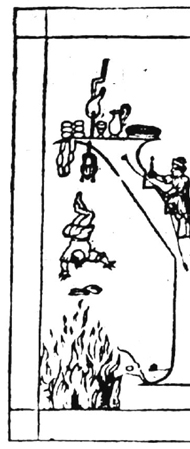Works Cited
Agamben, G. (2009). What is an Apparatus?: And Other Essays. Stanford University Press.
Anzaldúa, G. (1987). Borderlands/La Frontera: the New Mestiza. San Francisco: Aunt Lute Books.
Barthes, R. (1981). Camera Lucida. New York: Hill and Wang.
Bartholomae, D. (1995). Writing with Teachers: A Conversation with Peter Elbow.College Composition and Communication, 46 (1) 62-71.
Blair, K. (1998). Literacy, Dialogue, and Difference in the 'Electronic Contact Zone.' Computers and Composition, 15 (3) 317-29.
Bolter, J. (2009). Writing Space: Computers, Hypertext, and the Remediation of Print. Taylor and Francis.
Booth, W. (1974). Modern Dogma and the Rhetoric of Assent. Chicago: University Of Chicago Press.
Bruffee, K.A. (1984). Collaborative Learning and the 'Conversation of Mankind.' College English, 46 (7) 635-652.
Canagarajah, A. S. (2006). The Place of World Englishes in Composition: Pluralization Continued. College Composition and Communication, 57 (4) 586-619.
Cogswell, R. (2013). Crossroads of the Confederacy. Wikipedia Commons. Web. 3 July 2014.
Cream. (1968). Crossroads.Wheels of Fire. Polydor, Compact Disc.
Derrida, J. (1967). Of Grammatology. Baltimore: Johns Hopkins University Press.
Doty, W. G. in Enos. (2010). Myth. Encyclopedia of Rhetoric and Composition: Communication from Ancient Times to the Information Age. Routledge.
Ede, L. (2004). Situating Composition. Carbondale: Southern Illinois UP.
Flower, L, and J. R. Hayes. (1981). A Cognitive Process Theory of Writing. College Composition and Communication, 32 (4) 365-387.
Foucault, M. (1972). The Archaeology of Knowledge and the Discourse on Language. Vintage Books.
Genosko, G. (2005). Marshall McLuhan: Fashion and Fortune. Routledge.
Giroux, H. A. (2005). Border Crossings: Cultural Workers and the Politics of Education. Routledge.
Hall, S. (2013). Representation: Cultural Representations and Signifying Practices. SAGE Publications Ltd.
Haraway, D. (1991). A Cyborg Manifesto: Science, Technology, and Socialist-Feminism in the Late Twentieth Century. Simians, Cyborgs and Women: The Reinvention of Nature. Routledge.
Harrison, S. (2002). Our Cyberbodies, Ourselves: Conceptual Grounds for Teaching Commodities To Write. JAC: A Journal of Composition Theory, 22 (1) 37-56.
Hungerford, A. in Enos. (2010). Pre-Socratics. Encyclopedia of Rhetoric and Composition: Communication from Ancient Times to the Information Age. Routledge.
Johnson, R. (1936). Cross Road Blues. Ramblin' on my Mind. Vocalion. Record.
--Image retrieved from https://flic.kr/p/5TkMXZ
Johnson-Eilola, J. and S.A. Selber. (2007). Plagiarism, Originality, Assemblage. Computers and Composition, 24 (4) 375-403.
Kinneavy, J. (1969). The Basic Aims of Discourse. College Composition and Communication, 20 (5) 297-304.
Korzybski, A. (1933). A Non-Aristotelian System and its Necessity for Rigour in Mathematics and Physics. Science and Sanity. 747–61
Lefebvre, H. (2005). The Urban Revolution. The University of Minnesota Press.
Lu, Min-Zhan. (2006). Living-English Work. College English 68.6: 605-618.
Miller, S. (1991). Textual Carnivals: The Politics of Composition. Carbondale: Southern Illinois UP.
Moulthrop, S. Reading from the Map: Metonymy and Metaphor in the Fiction of Forking Paths. Hypermedia and Literary Studies. Paul Delany and George Landow, eds. Cambridge, MA: MIT Press, 119-32.
O’Keefe, D.L. (1982). Stolen Lightening: The Social Theory of Magic. New York: Continuum.
Pratt, M. L. (1991). Arts of the Contact Zone. Profession. (1991) 33-40.
Sarup, M. (1993). An Introductory Guide to Post-structuralism and Postmodernism. University of Georgia Press.
Selfe, C.L. and R. J. Selfe, Jr. (1994). The Politics of the Interface: Power and Its Exercise in Electronic Contact Zones. College Composition and Communication, 45 (4) 480-504.
Sprague, R.K. (1972). Gorgias Encomium of Helen in The Older Sophists. Columbia, South Carolina: University of South Carolina Press. 50-54
Tory, G. (1528). Ypsilon. Bibliothèque nationale de France, Paris. Web. 3 July 2014.
Trimbur, J. (1989). Consensus and Difference in Collaborative Learning. College English, 51 (6) 602-616.
Tucker, G.H. (2003). Homo Viator: Itineraries of Exile, Displacement and Writing in Renaissance. Geneva: Droz.
Ulmer, G. (2007). Text/Hypertext. Blackwell Encyclopedia of Sociology. Edited by: George Ritzer.
Wiley-Blackwell.
--Electronic Monuments. (2005). University of Minnesota.
--Heuretics: The Logic of Invention. (1994). John Hopkins UP.
--Internet Invention: From Literacy to Electracy. (2003). New York: Longman.
--Introduction: Electracy. (2007) Networked: a (networked_book) about (networked_art). Web. 31 October 2014.
Vygotsky, L.S. (1980). Mind in Society: The Development of Higher Psychological Processes. Harvard UP.
Williams, R.. (2011). Keywords: A Vocabulary of Culture and Society. Routledge.
Witte, S. and L. Faigley. (1981). Coherence,Cohesion, and Writing Quality. College Composition and Communication, 32 (2) 189-204.
*Other images have been created or personally taken by author.

